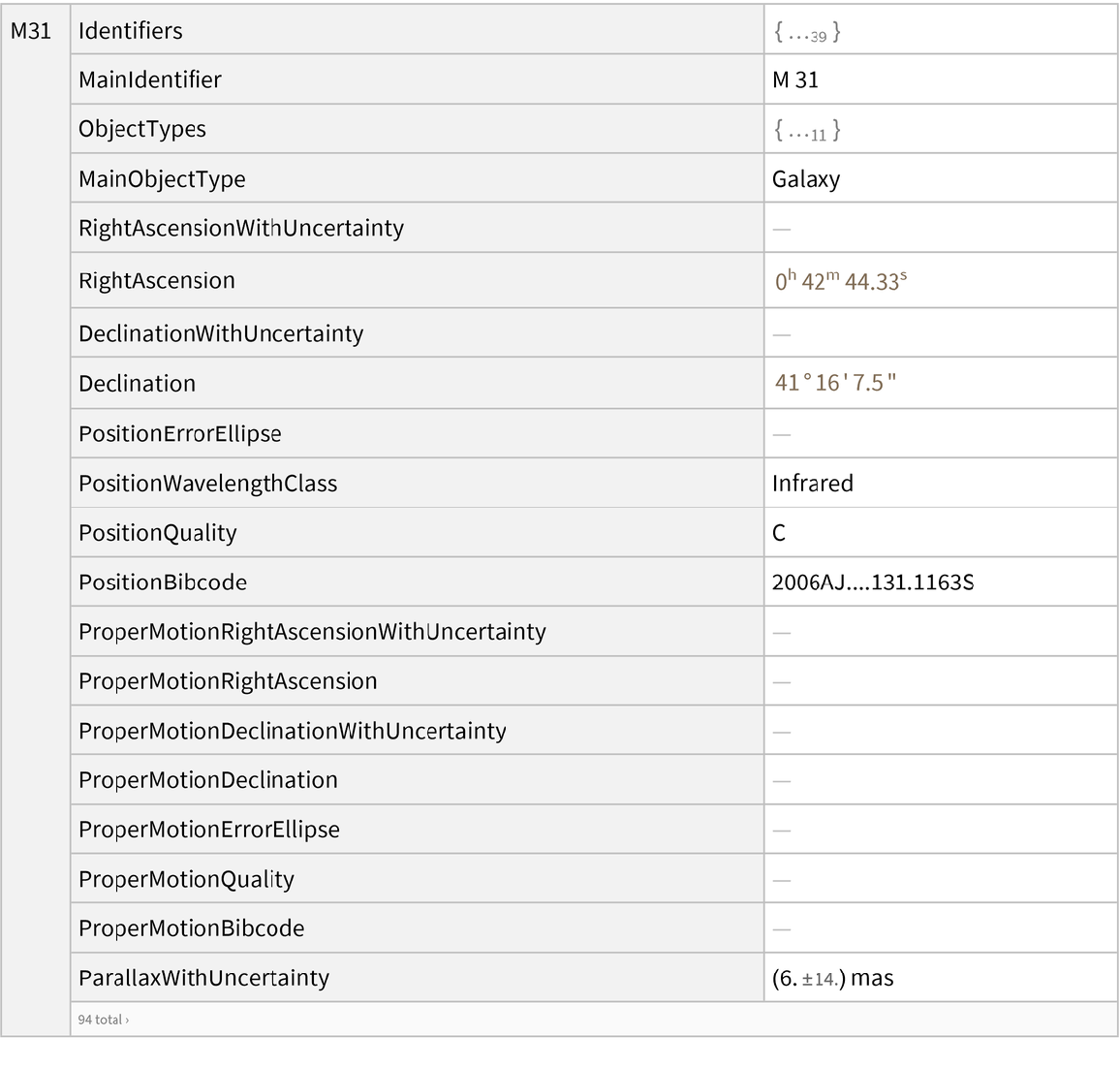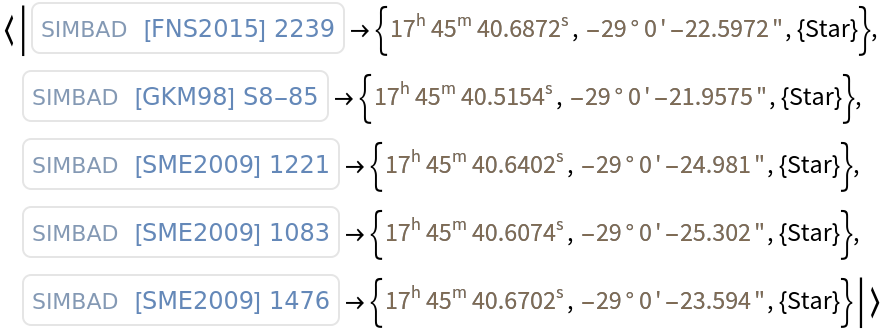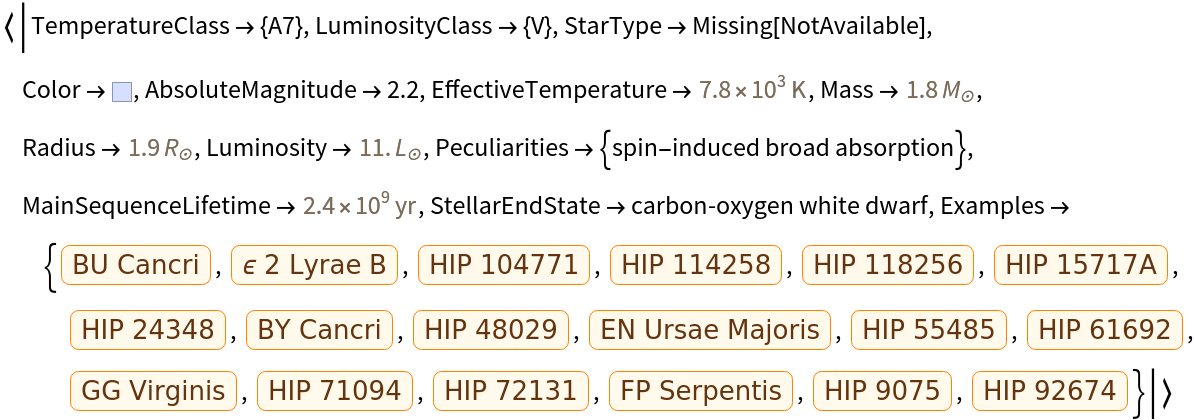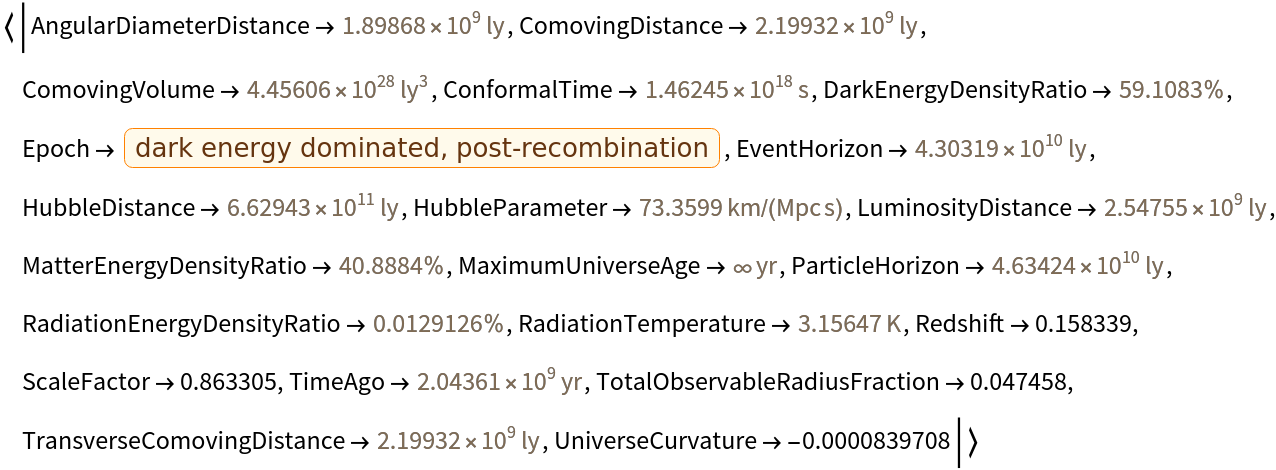Details and Options
ResourceFunction["SIMBADData"] retrieves data from
SIMBAD (Set of Identifications, Measurements and Bibliography for Astronomical Data) using the table access protocol (
TAP).
The astronomical object
obj can be specified as an
Entity or
String.
ResourceFunction["SIMBADData"]["Properties"] shows all the available properties.
ResourceFunction["SIMBADData"] takes the following option:
| "DataSource" | "France" | a String representing the source of the data, "US" and "France" are allowed |
If an
Association is used as the first argument, a sky region is interpreted from the values of the keys "AstroCenter" and "AstroRange";
MaxItems can specify the number of objects to retrieve.
"AstroCenter" takes the center of the circle; it can be an
Entity or
{ra,dec} specifying right ascension and declination.
"AstroRange" can take the following settings:
| r | explicit radius of a circle |
| {{ra1,ra2},{dec1,dec2}} | explicit limit for right ascension and declination |
| {{ra1,dec1},{ra2,dec2},{ra3,dec3},…} | a polygon constructed with the specified vertices |
| {entity1,entity2,entity3,…} | a polygon constructed using Entity objects as vertices |
All the angles that specify a sky region are assumed to be in degrees, but they can be
Quantity expressions as well.
The maximum number of astronomical objects that can be obtained at a time is 50 000 by a sky region query, but in an object query, this number is much lower.
The following modifiers can be used in ResourceFunction["SIMBADData"]["keywords",property,"modifier"]:
| "ObjectAssociation" | an association with the input objects as keys and their properties as values |
| "Association" | a nested association with object keys on the first level and property keys on the second level |
| "Dataset" | a dataset containing the same structure of the "Association" modifier |
| "ExternalIdentifierAssociation" | an association of SIMBAD external identifiers as keys and their properties as values |
![ResourceFunction["SIMBADData"][
Entity["Star", "HIP5054"], {"RightAscensionWithUncertainty", "DeclinationWithUncertainty"}]](https://www.wolframcloud.com/obj/resourcesystem/images/9a0/9a06e66d-a823-4a0e-99ac-3b8ab5ee210a/2-0-1/70585c4376a4fdea.png)
![ResourceFunction["SIMBADData", ResourceVersion->"2.0.1"][{"HD 3070", "HD 107596", "HD 142532", Entity["Star", "HIP5054"]}, "RadialVelocity", "ObjectAssociation"]](https://www.wolframcloud.com/obj/resourcesystem/images/9a0/9a06e66d-a823-4a0e-99ac-3b8ab5ee210a/2-0-1/0cdca94b35a7356b.png)

![]() centered at
centered at ![]() :
:![ResourceFunction["SIMBADData", ResourceVersion->"2.0.1"][<|
"AstroCenter" -> Entity["AstronomicalRadioSource", "SagittariusAStar"], "AstroRange" -> Quantity[5, "ArcMinutes"], MaxItems -> 5|>, {"RightAscension", "Declination", "ObjectTypes"}, "ObjectAssociation"]](https://www.wolframcloud.com/obj/resourcesystem/images/9a0/9a06e66d-a823-4a0e-99ac-3b8ab5ee210a/2-0-1/3ea32d4130cd557f.png)

![ResourceFunction["SIMBADData", ResourceVersion->"2.0.1"][<|
"AstroRange" -> {{Quantity[40, "MinutesOfRightAscension"], Quantity[50, "MinutesOfRightAscension"]}, {0, -2}}, MaxItems -> 5|>, {"RightAscension", "Declination", "ObjectTypes"}, "ExternalIdentifierAssociation"]](https://www.wolframcloud.com/obj/resourcesystem/images/9a0/9a06e66d-a823-4a0e-99ac-3b8ab5ee210a/2-0-1/24b3dae34b0cc51f.png)

![ResourceFunction["SIMBADData", ResourceVersion->"2.0.1"][<|
"AstroRange" -> {Entity["Star", "Unukalhai"], Entity["Star", "EtaSerpentis"], Entity["Star", "XiSerpentis"]}, MaxItems -> 5|>, {"RightAscension", "Declination", "ObjectTypes"}, "ObjectAssociation"]](https://www.wolframcloud.com/obj/resourcesystem/images/9a0/9a06e66d-a823-4a0e-99ac-3b8ab5ee210a/2-0-1/1ca4072202a6ba22.png)



